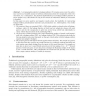191 search results - page 15 / 39 » Content-Based Positioning in Learning Networks |
PET
2005
Springer
14 years 6 days ago
2005
Springer
Parallel mixing [7] is a technique for optimizing the latency of a synchronous re-encryption mix network. We analyze the anonymity of this technique when an adversary can learn the...
CRYPTO
2010
Springer
13 years 7 months ago
2010
Springer
Abstract. A cryptographic primitive is leakage-resilient, if it remains secure even if an adversary can learn a bounded amount of arbitrary information about the computation with e...
BMCBI
2008
13 years 6 months ago
2008
Background: We present a novel method of protein fold decoy discrimination using machine learning, more specifically using neural networks. Here, decoy discrimination is represent...
GECCO
2009
Springer
13 years 11 months ago
2009
Springer
We apply CMA-ES, an evolution strategy with covariance matrix adaptation, and TDL (Temporal Difference Learning) to reinforcement learning tasks. In both cases these algorithms se...
IJCNN
2008
IEEE
14 years 1 months ago
2008
IEEE
Abstract— This paper proposes an approach to learn subjectindependent P300 models for EEG-based brain-computer interfaces. The P300 models are first learned using a pool of exis...

